Photo: Frederic J. Brown
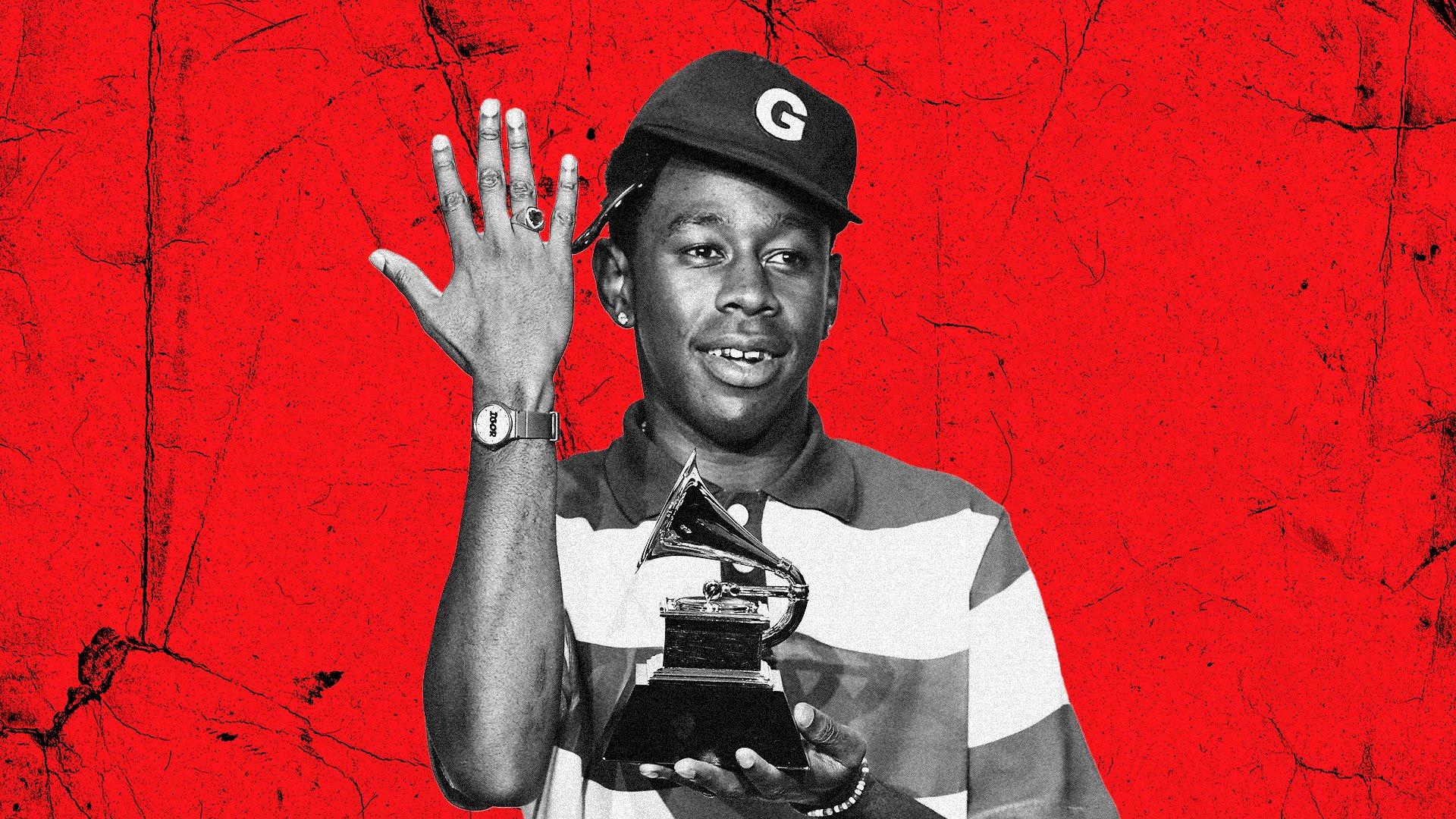
video
GRAMMY Rewind: Tyler, The Creator Shares Best Rap Album Win With His Nearest & Dearest At The 2020 GRAMMY Awards
As Tyler, The Creator took the stage to accept his GRAMMY award for Best Rap Album for 'IGOR' — his first golden gramophone — he brought two very special people up with him.
It takes a village to make a superstar, and no one knows that better than Tyler, The Creator. An eventful, detour-filled and perpetually left-of-center career in music spanning back to 2007 all came to a head in 2020, when the rapper won his very first GRAMMY award.
The latest episode of GRAMMY Rewind revisits Tyler's Best Rap Album win for his 2019 project IGOR at the 2020 GRAMMY Awards. But the true star of the show is his mother, Bonita Smith, who joined him onstage as he gave his acceptance speech.
After Smith gave her son a long, tearful hug before he could even give up to the microphone, Tyler made sure to shout her out first. "You did a great job raising this guy," Tyler said with a laugh.
The rapper — who admitted he didn't have anything prepared — spent the bulk of his time onstage offering heartfelt, specific thanks to all the people who helped foster his career. Next, he applauded his managers, who "took a seed and watered it"; then, his friends and family, "for putting up with my annoying, hyperactive energy."
In particular, Tyler wanted to mention another person who was beside him on stage: His longtime friend and collaborator Jasper. Jasper was a founding member of Tyler's mid-2000s hip hop collective, Odd Future, and he's been featured on multiple Tyler, The Creator albums over the years.
"This man has never missed a show of mine," Tyler proclaimed. "This is my day one, and I love this dude."
Though his 2020 win wouldn't be his last GRAMMY trophy — Tyler won Best Rap Album again at the 64th GRAMMY Awards in 2022, for Call Me If You Get Lost — he soaked up the spotlight as if he would never get the chance to do so again, and made sure to let his nearest and dearest know that it was their moment, too.
Watch Tyler's full acceptance speech above, and check back at GRAMMY.com every Friday for more episodes of GRAMMY Rewind.
Erica Banks Hustled To "Buss It": Meet The South Dallas Rapper Making Waves On TikTok And Beyond
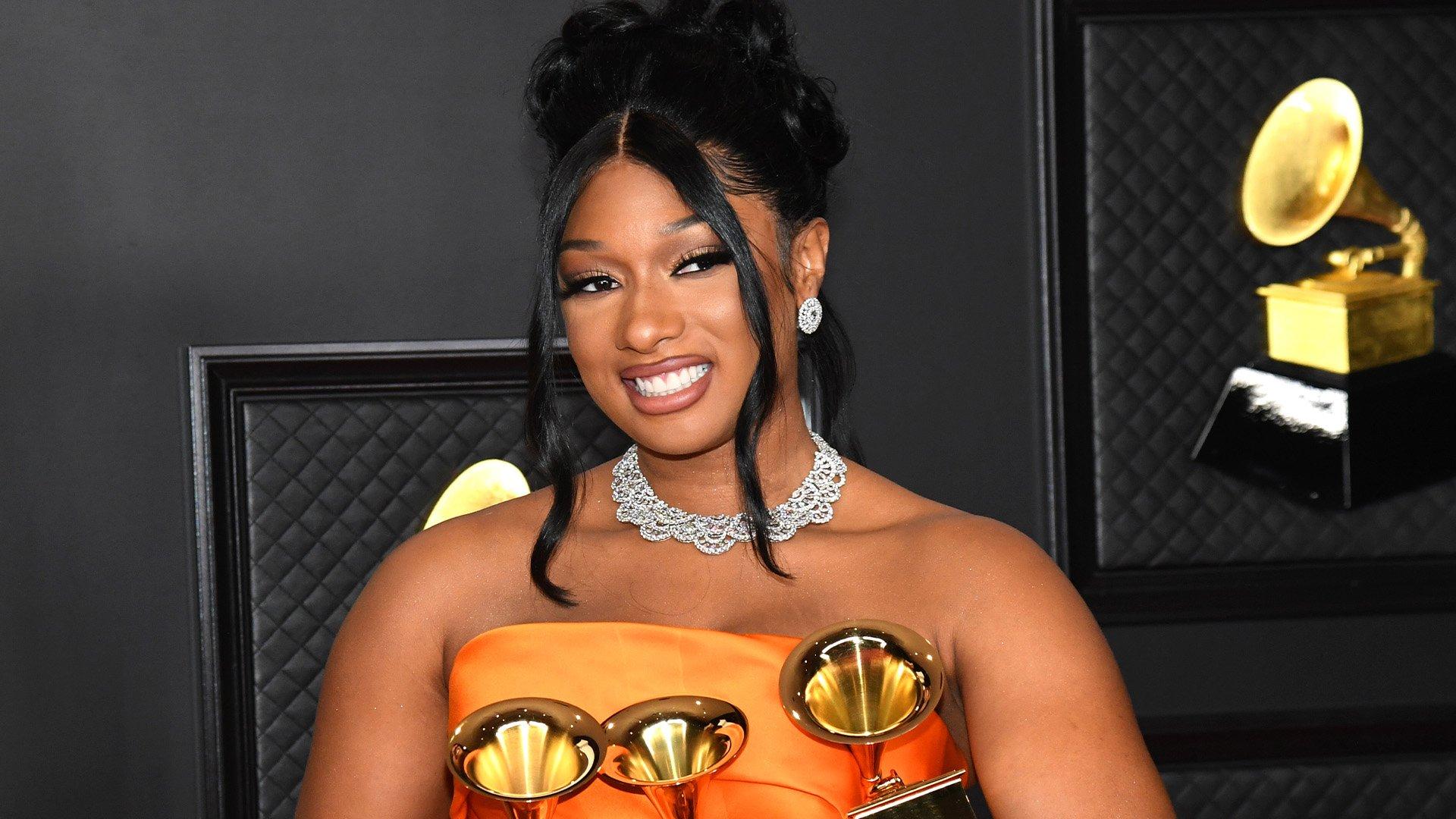
Photo: Kevin Mazur/Getty Images for The Recording Academy
video
GRAMMY Rewind: Megan Thee Stallion Went From "Savage" To Speechless After Winning Best New Artist In 2021
Relive the moment Megan Thee Stallion won the coveted Best New Artist honor at the 2021 GRAMMYs, where she took home three golden gramophones thanks in part to her chart-topping smash "Savage."
In 2020, Megan Thee Stallion solidified herself as one of rap's most promising new stars, thanks to her hit single "Savage." Not only was it her first No. 1 song on the Billboard Hot 100, but the "sassy, moody, nasty" single also helped Megan win three GRAMMYs in 2021.
In this episode of GRAMMY Rewind, revisit the sentimental moment the Houston "Hottie" accepted one of those golden gramophones, for Best New Artist.
"I don't want to cry," Megan Thee Stallion said after a speechless moment at the microphone. Before starting her praises, she gave a round of applause to her fellow nominees in the category, who she called "amazing."
Along with thanking God, she also acknowledged her manager, T. Farris, for "always being with me, being by my side"; her record label, 300 Entertainment, for "always believing in me, sticking by through my craziness"; and her mother, who "always believed I could do it."
Megan Thee Stallion's "Savage" remix with Beyoncé also helped her win Best Rap Song and Best Rap Performance that night — marking the first wins in the category by a female lead rapper.
Press play on the video above to watch Megan Thee Stallion's complete acceptance speech for Best New Artist at the 2021 GRAMMY Awards, and remember to check back to GRAMMY.com for more new episodes of GRAMMY Rewind.
Black Sounds Beautiful: How Megan Thee Stallion Turned Viral Fame Into A GRAMMY-Winning Rap Career
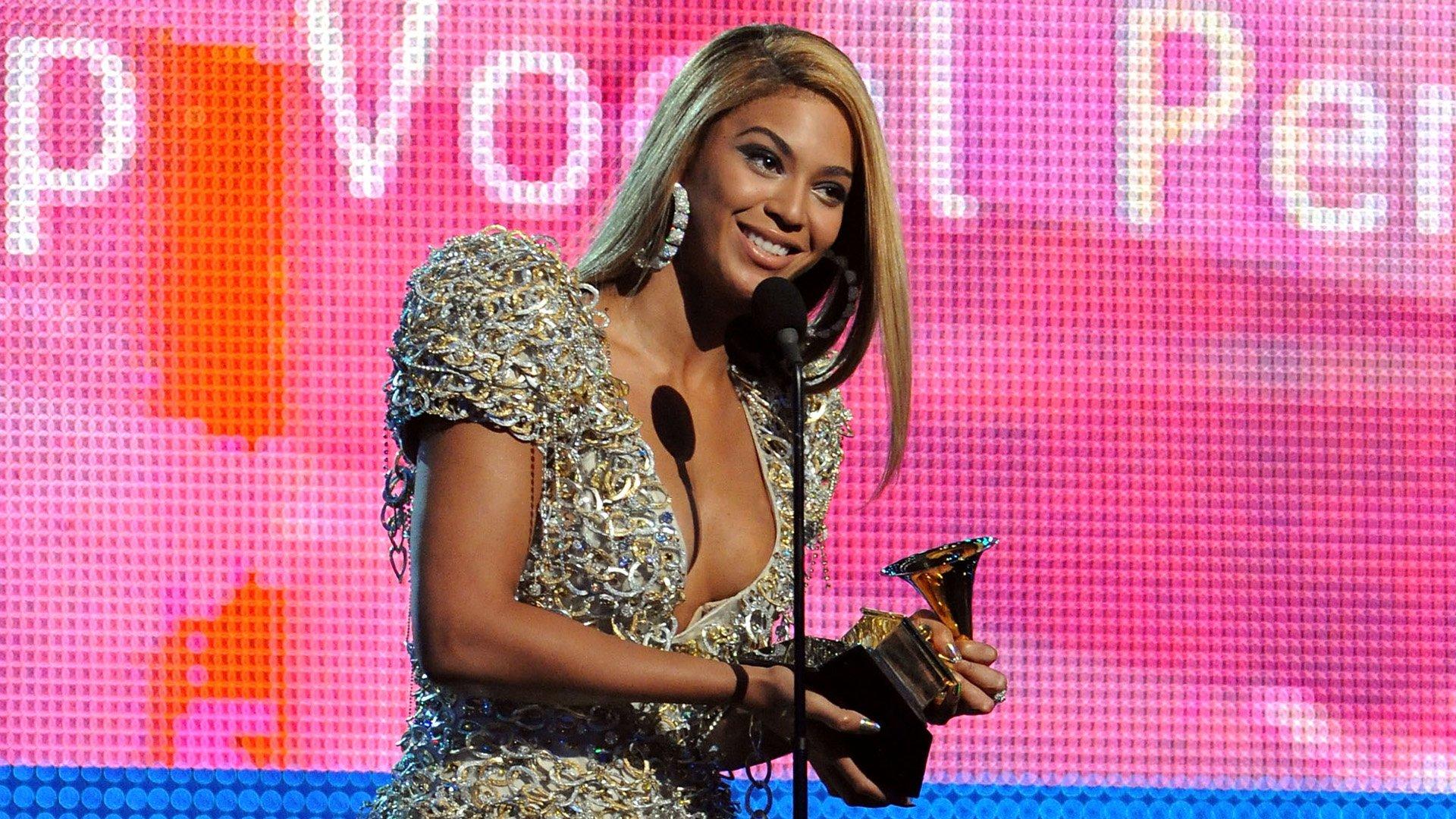
Photo: Jeff Kravitz/FilmMagic
video
GRAMMY Rewind: Watch Beyoncé Win A GRAMMY For "Halo" During Her Record-Setting Night In 2010
As you dive into Beyoncé's new album, 'COWBOY CARTER,' revisit the moment Queen Bey won a GRAMMY for "Halo," one of six golden gramophones she won in 2010.
Amongst Beyoncé's expansive catalog, "Halo" is easily one of her most iconic songs. Today, the 2009 single is her most-streamed song on Spotify; it was her first video to reach one billion views on YouTube; and it helped her set one of her GRAMMY records in 2010.
In this episode of GRAMMY Rewind, watch the superstar take the stage to accept Best Female Pop Vocal Performance for "Halo" in 2010 — the year she became the first female artist to win six GRAMMYs in one night.
"This has been such an amazing night for me, and I'd love to thank the GRAMMYs," she said, admitting she was nervous before taking a deep breath.
Before leaving the stage, Beyoncé took a second to thank two more special groups: "I'd love to thank my family for all of their support, including my husband. I love you. And I'd like to thank all of my fans for their support over the years."
The five other awards Beyoncé took home that night were for the coveted Song Of The Year ("Single Ladies (Put A Ring On It)") and four R&B Categories: Best Contemporary R&B Album (I Am... Sasha Fierce), Best R&B Song ("Single Ladies"), Best Female R&B Vocal Performance ("Single Ladies"), and Best Traditional R&B Vocal Performance (for her cover of Etta James' "At Last").
As of 2024, Beyoncé has won the most GRAMMY Awards in history with 32 wins.
Press play on the video above to relive Queen Bey's "Halo" win for Best Female Pop Vocal Performance, and check back to GRAMMY.com for more new episodes of GRAMMY Rewind.
Enter The World Of Beyoncé
Beyond Country: All The Genres Beyoncé Explores On 'Cowboy Carter'
Beyoncé Is The Genre-Bending Queen On 'Cowboy Carter': 5 Takeaways From Her New Album
Beyoncé's New Album 'Cowboy Carter' Is Here: Check Out The Featured Artists, Cover Songs, And Tracklist
Everything We Know About Beyoncé's New Album, 'Cowboy Carter': Two New Singles, Tracklist, A Shift To Country & More
How Beyoncé Is Honoring Black Music History With 'Cowboy Carter,' "Texas Hold Em," 'Renaissance' & More
Songbook: The Complete Guide To The Albums, Visuals & Performances That Made Beyoncé A Cultural Force
A Timeline Of Beyoncé's GRAMMY Moments, From Her First Win With Destiny's Child to Making History With 'Renaissance'
How Many GRAMMYs Has Beyoncé Won? 10 Questions About The 'Renaissance' Singer Answered

Watch Beyoncé Make GRAMMY History With Her 32nd Win In 2023 | GRAMMY Rewind
6 Takeaways From 'Renaissance: A Film By Beyoncé'
Beyoncé's 'Dangerously In Love' Turns 20: How The Solo Debut Foreshadowed The Singer's Icon Status
5 Takeaways From Beyoncé's New Album 'Renaissance'

How Beyoncé Has Empowered The Black Community Across Her Music And Art | Black Sounds Beautiful

The Creative Rebirth Of Beyoncé On '4' | For The Record
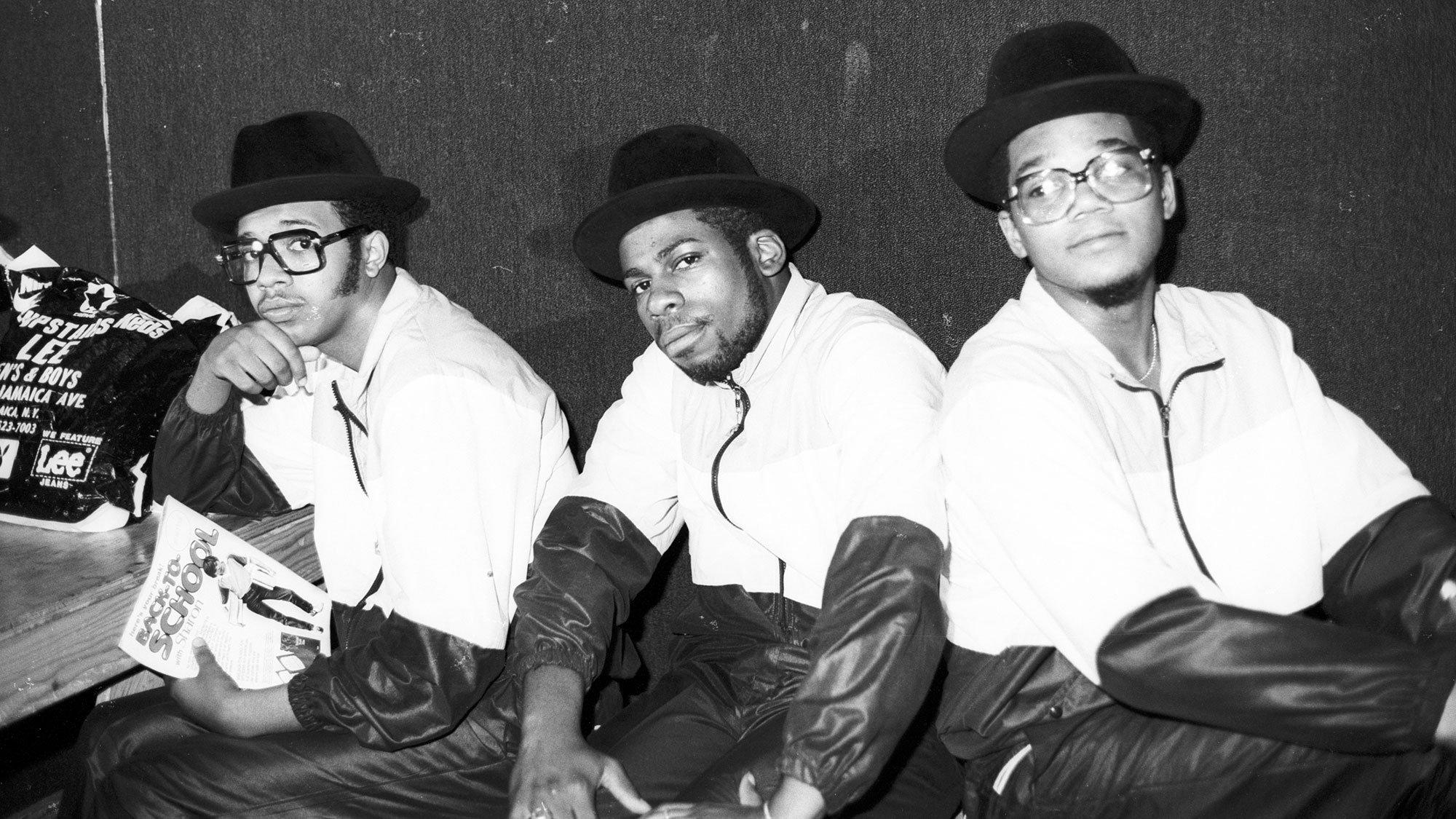
Photo: Michael Ochs Archives/Getty Images
feature
'Run-DMC' At 40: The Debut Album That Paved The Way For Hip-Hop's Future
Forty years ago, Run-DMC released their groundbreaking self-titled album, which would undeniably change the course of hip-hop. Here's how three guys from Queens, New York, defined what it meant to be "old school" with a record that remains influential.
"You don't know that people are going to 40 years later call you up and say, ‘Can you talk about this record from 40 years ago?’"
That was Cory Robbins, former president of Profile Records, reaction to speaking to Grammy.com about one of the first albums his then-fledgling label released. Run-DMC’s self-titled debut made its way into the world four decades ago this week on March 27, 1984 and established the group, in Robbins’ words, "the Beatles of hip-hop."
Rarely in music, or anything else, is there a clear demarcation between old and new. Styles change gradually, and artistic movements usually get contextualized, and often even named, after they’ve already passed from the scene. But Run-DMC the album, and the singles that led up to it, were a definitive breaking point. Rap before it instantly, and eternally, became “old school.” And three guys from Hollis, Queens — Joseph "Run" Simmons, Jason "Jam Master Jay" Mizell, Darryl "D.M.C." McDaniels — helped turn a burgeoning genre on its head.
What exactly was different about Run-DMC? Some of the answers can be glimpsed by a look at the record’s opening song. "Hard Times" is a cover of a Kurtis Blow track from his 1980 debut album. The connection makes sense. Kurtis and Run’s older brother Russell Simmons met in college, and Russell quickly became the rapper’s manager. That led to Run working as Kurtis’ DJ. Larry Smith, who produced Run-DMC, even played on Kurtis’ original version of the song.
But despite those tie-ins, the two takes on "Hard Times" are night and day. Kurtis Blow’s is exactly what rap music was in its earliest recorded form: a full band playing something familiar (in this case, a James Brown-esque groove, bridge and percussion breakdown inclusive.)
What Run-DMC does with it is entirely different. The song is stripped down to its bare essence. There’s a drum machine, a sole repeated keyboard stab, vocals, and… well, that’s about it. No solos, no guitar, no band at all. Run and DMC are trading off lines in an aggressive near-shout. It’s simple and ruthlessly effective, a throwback to the then-fading culture of live park jams. But it was so starkly different from other rap recordings of the time, which were pretty much all in the style of Blow’s record, that it felt new and vital.
"Production-wise, Sugar Hill [the record label that released many key early rap singles] built themselves on the model of Motown, which is to say, they had their own production studios and they had a house band and they recorded on the premises," explains Bill Adler, who handled PR for Run-DMC and other key rap acts at the time.
"They made magnificent records, but that’s not how rap was performed in parks," he continues. "It’s not how it was performed live by the kids who were actually making the music."
Run-DMC’s musical aesthetic was, in some ways, a lucky accident. Larry Smith, the musician who produced the album, had worked with a band previously. In fact, the reason two of the songs on the album bear the subtitle "Krush Groove" is because the drum patterns are taken from his band Orange Krush’s song “Action.”
Read more: Essential Hip-Hop Releases From The 1970s: Kurtis Blow, Grandmaster Flash, Sugarhill Gang & More
But by the time sessions for Run-DMC came around, the money had run out and, despite his desire to have the music done by a full band, Smith was forced to go without them and rely on a drum machine.
His artistic partner on the production side was Russell Simmons. Simmons, who has been accused over the past seven years of numerous instances of sexual assault dating back decades, was back in 1983-4 the person providing the creative vision to match Smith’s musical knowledge.
Orange Krush’s drummer Trevor Gale remembered the dynamic like this (as quoted in Geoff Edgers’ Walk This Way: Run-DMC, Aerosmith, and the Song that Changed American Music Forever): “Larry was the guy who said, 'Play four bars, stop on the fifth bar, come back in on the fourth beat of the fifth bar.' Russell was the guy that was there that said, ‘I don’t like how that feels. Make it sound like mashed potato with gravy on it.’”
Explore The Artists Who Changed Hip-Hop
50 Artists Who Changed Rap: Jay-Z, The Notorious B.I.G., Dr. Dre, Nicki Minaj, Kendrick Lamar, Eminem & More
Hip-Hop Just Rang In 50 Years As A Genre. What Will Its Next 50 Years Look Like?

Watch Outkast Humbly Win Album Of The Year For 'Speakerboxxx/The Love Below' In 2004 | GRAMMY Rewind
A Brief History Of Hip-Hop At 50: Rap's Evolution From A Bronx Party To The GRAMMY Stage
GRAMMY Museum To Celebrate 50 Years Of Hip-Hop With 'Hip-Hop America: The Mixtape Exhibit' Opening Oct. 7

Watch Eminem Show Love to Detroit And Rihanna During Best Rap Album Win In 2011 | GRAMMY Rewind
Listen To GRAMMY.com's 50th Anniversary Of Hip-Hop Playlist: 50 Songs That Show The Genre's Evolution
14 New Female Hip-Hop Artists To Know In 2023: Lil Simz, Ice Spice, Babyxsosa & More
6 Artists Expanding The Boundaries Of Hip-Hop In 2023: Lil Yachty, McKinley Dixon, Princess Nokia & More
Watch 41 Bring The Hype With A Cover Of DMX's Hit "Party Up (Up In Here)" | Hip-Hop Re:Defined
The 10 Most Controversial Samples In Hip-Hop History

Watch Lauryn Hill Win Best New Artist At The 1999 GRAMMYs | GRAMMY Rewind
19 Concerts And Events Celebrating The 50th Anniversary Of Hip-Hop
Founding Father DJ Kool Herc & First Lady Cindy Campbell Celebrate Hip-Hop’s 50th Anniversary
A Guide To New York Hip-Hop: Unpacking The Sound Of Rap's Birthplace From The Bronx To Staten Island
A Guide To Southern California Hip-Hop: Definitive Releases, Artists & Subgenres From L.A. & Beyond
10 Crucial Hip-Hop Albums Turning 30 In 2023: 'Enter The Wu-Tang,' 'DoggyStyle,' 'Buhloone Mindstate' & More
The Nicki Minaj Essentials: 15 Singles To Showcase Her Rap And Pop Versatility
11 Hip-Hop Subgenres To Know: From Jersey Club To G-Funk And Drill
5 Essential Hip-Hop Releases From The 2020s: Drake, Lil Baby, Ice Spice, 21 Savage & More
A Guide To Southern Hip-Hop: Definitive Releases, Artists & Subgenres From The Dirty South
A Guide To Bay Area Hip-Hop: Definitive Releases, Artists & Subgenres From Northern California
A Guide To Texas Hip-Hop: Definitive Releases, Artists & Events

Ludacris Dedicates 2007 Best Rap Album GRAMMY To His Dad | GRAMMY Rewind
Unearthing 'Diamonds': Lil Peep Collaborator ILoveMakonnen Shares The Story Behind Their Long-Awaited Album
10 Bingeworthy Hip-Hop Podcasts: From "Caresha Please" To "Trapital"
Revisiting 'The Miseducation Of Lauryn Hill': Why The Multiple GRAMMY-Winning Record Is Still Everything 25 Years Later
Watch Asha Imuno Personalize Kendrick Lamar's "i" With A Sparkling New Chorus | Hip-Hop Re:Defined
10 Must-See Exhibitions And Activations Celebrating The 50th Anniversary Of Hip-Hop
5 Artists Showing The Future Of AAPI Representation In Rap: Audrey Nuna, TiaCorine & More
'Invasion of Privacy' Turns 5: How Cardi B's Bold Debut Album Redefined Millennial Hip-Hop
10 Songs That Show Doja Cat’s Rap Skills: From "Vegas" To "Tia Tamara" & "Rules"
Watch Olen Put A Dreamy, Melodic Spin On Childish Gambino's "Heartbeat" | Hip-Hop Re:Defined
6 Must-Watch Hip-Hop Documentaries: 'Hip-Hop x Siempre,' 'My Mic Sounds Nice' & More...
Essential Hip-Hop Releases From The 2010s: Ye, Cardi B, Kendrick Lamar & More
6 Takeaways From Netflix's "Ladies First: A Story Of Women In Hip-Hop"
How Drake & 21 Savage Became Rap's In-Demand Duo: A Timeline Of Their Friendship, Collabs, Lawsuits And More
5 Takeaways From Travis Scott's New Album 'UTOPIA'
Essential Hip-Hop Releases From The 2000s: T.I., Lil Wayne, Kid Cudi & More
Songbook: How Jay-Z Created The 'Blueprint' For Rap's Greatest Of All Time
Ladies First: 10 Essential Albums By Female Rappers

How Megan Thee Stallion Turned Viral Fame Into A GRAMMY-Winning Rap Career | Black Sounds Beautiful
How Hip-Hop Took Over The 2023 GRAMMYs, From The Golden Anniversary To 'God Did'
5 Things We Learned At "An Evening With Chuck D" At The GRAMMY Museum
Remembering De La Soul’s David Jolicoeur, a.k.a. Dave and Trugoy the Dove: 5 Essential Tracks
Catching Up With Hank Shocklee: From Architecting The Sound Of Public Enemy To Pop Hits & The Silver Screen
Meet The First-Time GRAMMY Nominee: GloRilla On Bonding with Cardi B, How Faith And Manifestation Helped Her Achieve Success
Hip-Hop's Secret Weapon: Producer Boi-1da On Working With Kendrick, Staying Humble And Doing The Unorthodox
Essential Hip-Hop Releases From The 1990s: Snoop Dogg, Digable Planets, Jay-Z & More
10 Albums That Showcase The Deep Connection Between Hip-Hop And Jazz: De La Soul, A Tribe Called Quest, Kendrick Lamar & More
Hip-Hop Education: How 50 Years Of Music & Culture Impact Curricula Worldwide
Women In Hip-Hop: 7 Trailblazers Whose Behind-The-Scenes Efforts Define The Culture

Watch Flavor Flav Crash Young MC's Speech After "Bust A Move" Wins In 1990 | GRAMMY Rewind
Essential Hip-Hop Releases From The 1980s: Slick Rick, RUN-D.M.C., De La Soul & More
Lighters Up! 10 Essential Reggae Hip-Hop Fusions

How Lil Nas X Turned The Industry On Its Head With "Old Town Road" & Beyond | Black Sounds Beautiful
9 Teen Girls Who Built Hip-Hop: Roxanne Shante, J.J. Fadd, Angie Martinez & More
Essential Hip-Hop Releases From The 1970s: Kurtis Blow, Grandmaster Flash, Sugarhill Gang & More
Killer Mike Says His New Album, 'Michael,' Is "Like A Prodigal Son Coming Home"
5 Takeaways From 'TLC Forever': Left-Eye's Misunderstood Reputation, Chilli's Motherhood Revelation, T-Boz's Health Struggles & More
Watch Eva B Perform "Sunrise In Lyari" Through The Streets Of Pakistan | Global Spin
It wasn’t just the music that set Run-DMC apart from its predecessors. Their look was also starkly different, and that influenced everything about the group, including the way their audience viewed them.
Most of the first generation of recorded rappers were, Bill Adler remembers, influenced visually by either Michael Jackson or George Clinton and Parliament-Funkadelic. Run-DMC was different.
"Their fashion sense was very street oriented," Adler explains. "And that was something that emanated from Jam Master Jay. Jason just always had a ton of style. He got a lot of his sartorial style from his older brother, Marvin Thompson. Jay looked up to his older brother and kind of dressed the way that Marvin did, including the Stetson hat.
"When Run and D told Russ, Jason is going to be our deejay, Russell got one look at Jay and said, ‘Okay, from now on, you guys are going to dress like him.’"
Run, DMC, and Jay looked like their audience. That not only set them apart from the costumed likes of Grandmaster Flash and the Furious Five, it also cemented the group’s relationship with their listeners.
"When you saw Run-DMC, you didn’t see celebrity. You saw yourself," DMC said in the group’s recent docuseries.
Read more: 20 Iconic Hip-Hop Style Moments: From Run-D.M.C. To Runways
Another thing that set Run-DMC (the album) and Run-DMC (the group) apart from what came before was the fact that they released a cohesive rap album. Nine songs that all belonged together, not just a collection of already-released singles and some novelties. Rappers had released albums prior to Run-DMC, but that’s exactly what they were: hits and some other stuff — sung love ballads or rock and roll covers, or other experiments rightfully near-forgotten.
"There were a few [rap] albums [at the time], but they were pretty crappy. They were usually just a bunch of singles thrown together," Cory Robbins recalls.
Not this album. It set a template that lasted for years: Some social commentary, some bragging, a song or two to show off the DJ. A balance of records aimed at the radio and at the hard-core fans. You can still see traces of Run-DMC in pretty much every rap album released today.
Listeners and critics reacted. The album got a four-star review in Rolling Stone with “the music…that backs these tracks is surprisingly varied, for all its bare bones” and an A minus from Robert Christgau who claimed “It's easily the canniest and most formally sustained rap album ever.” Just nine months after its release, Run-DMC was certified gold, the first rap LP ever to earn that honor. "Rock Box" also single-handedly invented rap-rock, thanks to Eddie Martinez’s loud guitars.
There is another major way in which the record was revolutionary. The video for "Rock Box" was the first rap video to ever get into regular rotation on MTV and, the first true rap video ever played on the channel at all, period. Run-DMC’s rise to MTV fame represented a significant moment in breaking racial barriers in mainstream music broadcasting.
"There’s no overstating the importance of that video," Adler tells me. vIt broke through the color line at MTV and opened the door to a cataclysmic change."
"Everybody watched MTV forty years ago," Robbins agrees. "It was a phenomenal thing nationwide. Even if we got three or four plays a week of ‘Rock Box’ on MTV, that did move the needle."
All of this: the new musical style, the relatable image, the MTV pathbreaking, and the attendant critical love and huge sales (well over 10 times what their label head was expecting when he commissioned the album from a reluctant Russell Simmons — "I hoping it would sell thirty or forty thousand," Robbins says now): all of it contributed to making Run-DMC what it is: a game-changer.
"It was the first serious rap album," Robbins tells me. And while you could well accuse him of bias — the group making an album at all was his idea in the first place — he’s absolutely right.
Run-DMC changed everything. It split the rap world into old school and new school, and things would never be the same.
Perhaps the record’s only flaw is one that wouldn’t be discovered for years. As we’re about to get off the phone, Robbins tells me about a mistake on the cover, one he didn’t notice until the record was printed and it was too late.
There was something (Robbins doesn’t quite recall what) between Run and DMC in the cover photo. The art director didn’t like it and proceeded to airbrush it out. But he missed something. On the vinyl, if you look between the letters "M" and "C,", you can see DMC’s disembodied left hand, floating ghost-like in mid-air. While it was an oversight, it’s hard not to see this as a sign, a sort of premonition that the album itself would hang over all of hip-hop, with an influence that might be hard to see at first, but that never goes away.
A Guide To New York Hip-Hop: Unpacking The Sound Of Rap's Birthplace From The Bronx To Staten Island
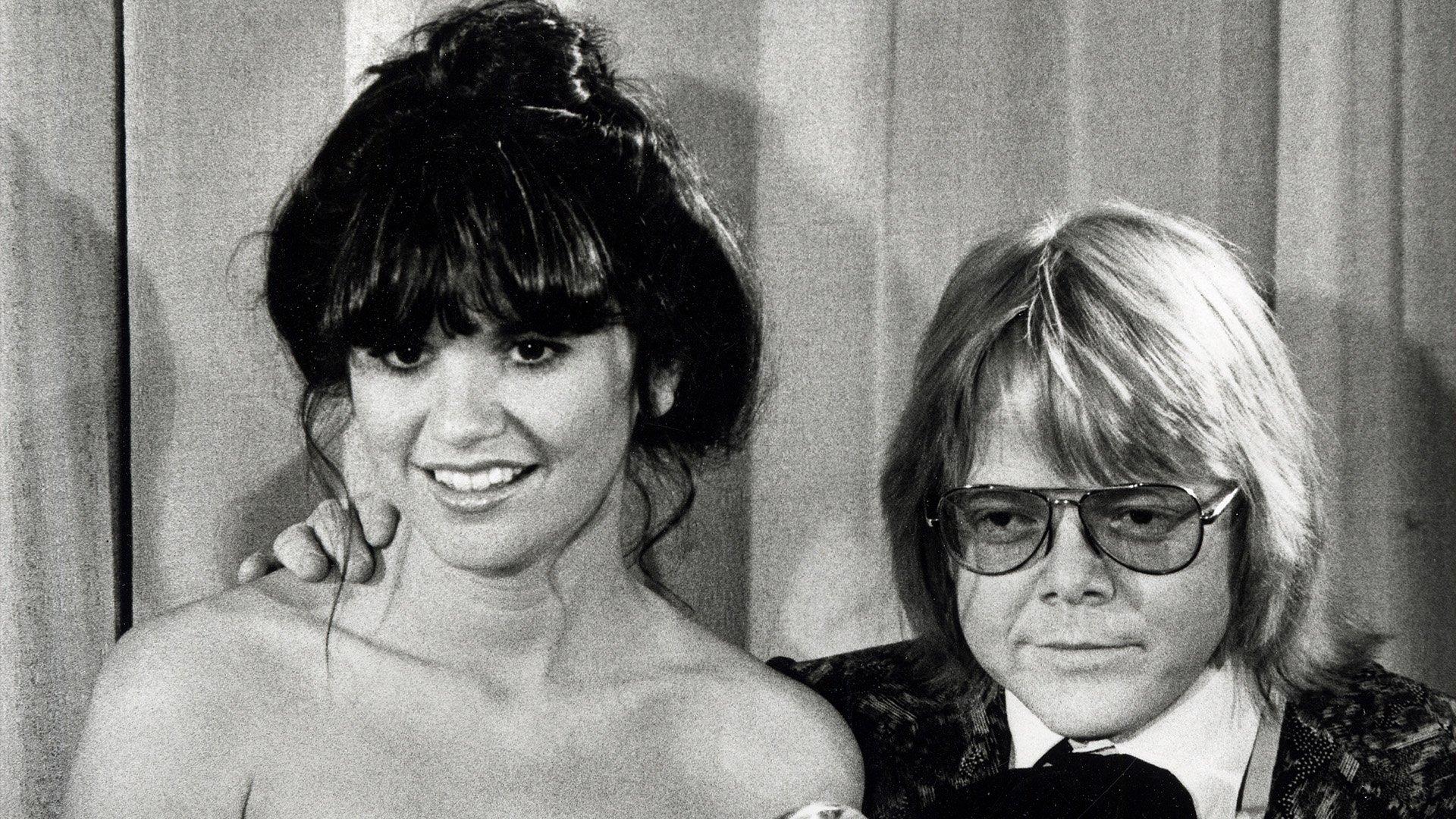
Photo: Ron Galella/Ron Galella Collection via Getty Images
video
GRAMMY Rewind: Watch Linda Ronstadt's Sweet & Simple Acceptance Speech In 1977
When Linda Ronstadt won a GRAMMY for Best Female Pop Vocal Performance — for her seventh album, 'Hasten Down the Wind' — she only had one special person in mind: her producer, Peter Asher.
With Hasten Down the Wind, Linda Ronstadt became the first female artist with three million-selling albums in a row — and furthered her legacy as one of the pioneers of women in rock music.
The album also helped Ronstadt snag her second GRAMMY, as it won Best Female Pop Vocal Performance in 1977. (The year prior, she took home Best Female Country Vocal Performance for her cover of Hank Williams' "I Can't Help It (If I'm Still in Love With You).")
In this episode of GRAMMY Rewind, relive the moment Linda Ronstadt won Best Female Pop Vocal Performance for Hasten Down the Wind in 1977.
Ronstadt kept her acceptance speech short and sweet: "I'd especially like to thank Peter Asher," the producer of the pop rock LP. "Thank you," she added with a smile.
To date, Ronstadt has won 11 GRAMMYs and received 27 nominations. In 2011 and 2016, respectively, she received a Latin GRAMMY Lifetime Achievement Award and a GRAMMY Lifetime Achievement Award.
Press play on the video above to watch Linda Ronstadt take the stage to accept Best Pop Vocal Performance at the 19th Annual GRAMMY Awards and remember to keep checking back to GRAMMY.com for more new episodes of GRAMMY Rewind.
5 Songs To Get Into Kim Gordon's Solo Work, From "Change My Brain" To "I'm A Man"
